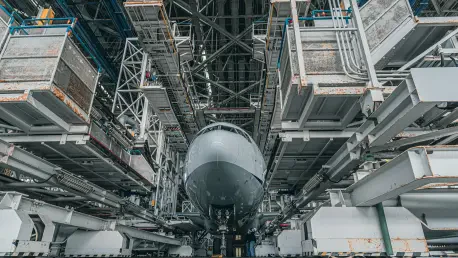In the aftermath of the COVID-19 pandemic, the global aerospace industry finds itself confronting a dynamic and challenging landscape. As it navigates the complexities of post-pandemic recovery, the sector must reconcile the burgeoning demand for aircraft with intricate supply chain obstacles. This balance is crucial, as the industry’s recovery is marked by the dual pressures of heightened geopolitical tensions and intrinsic supply chain vulnerabilities. Understanding these dynamics is vital for aerospace stakeholders aiming to harness growth opportunities while strategically avoiding potential pitfalls. Insights into these challenges are essential for charting a path forward in this increasingly complex environment.
Growth Dynamics in a Rebounding Sector
Surge in Demand
The aerospace sector is currently witnessing an intriguing pattern, where the demand for both commercial and defense aircraft is on the rise. This resurgence is characterized by an impressive backlog of commercial aircraft orders, signaling potential economic benefits that may revitalize local economies. One of the significant factors underpinning this growth is the observed boom in global travel, which has bounced back with vigor following the pandemic-induced slump. Passenger numbers have soared as international travel restrictions eased, encouraging airlines to place new orders to modernize and expand their fleets. This uptick aligns with strategic industry forecasts, further affirming the sector’s revived momentum.
Concomitantly, the defense segment is experiencing a surge due to geopolitical developments that fuel increased defense spending across various nations. Governments are pushing for enhanced military capabilities, thus stimulating demand for advanced defense aircraft. The demand for systems such as the Eurofighter Typhoon reflects how current political conditions are shaping strategic investments within aerospace. However, it’s crucial to recognize that these burgeoning opportunities are intertwined with the industry’s current supply chain weaknesses. The challenge lies in effectively managing these demands against the backdrop of intricate operational constraints and external risks inherent to the landscape.
Impact of Geopolitical Factors
The rising geopolitical tensions have indeed emerged as a pivotal driver of demand within the aerospace sector, significantly influencing both commercial and defense domains. This changing landscape is emblematic of how defense budgets are expanding globally, with countries prioritizing national security amidst the specter of international conflicts. In such an environment, purchases of cutting-edge military aircraft are rising, symbolizing the geopolitical climate’s direct correlation to industry fortune. Orders for sophisticated aircraft like the Eurofighter Typhoon underscore the intertwining of defense priorities and escalating political temperatures worldwide.
However, these tectonic shifts also come with inherent risks that aerospace manufacturers must judiciously navigate. The interplay between geopolitical dynamics and the aerospace sector presents a complex picture where opportunities are counterbalanced by uncertainties. Elected governments with varying international policies, trade liberalization pivotal to the sector’s sourcing strategies, and fluctuating political alliances introduce variables that can unexpectedly disrupt supply chains. Navigating this environment necessitates not only strategic resilience on the part of manufacturers but also a nuanced foresight to anticipate and mitigate interconnected risks.
Supply Chain Pressures and Challenges
Friction Points in Production
Despite the demand surge, the aerospace sector is not immune to the intense pressure imposed by supply chain disruptions that continue to challenge its recovery trajectory. The complex process of scaling up production levels seamlessly to meet escalating orders is fraught with obstacles, chiefly in terms of raw material availability. An acute shortage of critical components and materials is compounded by the complexities of modern manufacturing practices, leading to friction points that hinder effective output. As manufacturers attempt to expedite production to align with demand, bottlenecks inevitably arise, occasionally exacerbated by issues within engine supply networks like those with Rolls-Royce.
Supply chain inefficiencies exemplified by Rolls-Royce’s difficulties in maintaining sufficient spare parts for Trent 1000 engines spotlight how these disruptions impact beyond the production floor, affecting operations of key clientele such as British Airways. The repercussions of such disruptions extend into logistical operations, sustaining undesirable inventory levels and protracting cash conversion cycles. The vitality of supply chains to the aerospace sector means that resolving these issues is imperative. Navigating this minefield calls for innovative approaches to inventory management, augmented by strategic alliances with suppliers capable of bolstering resilience.
Economic and Trade Tensions
The economic and trade atmosphere globally is undergoing significant strains, compounded by the disruptive impact of shifting international policies and tariff impositions that ripple into aerospace supply chains. The anticipation of new policies from influential administrations, reminiscent of the trade tensions seen previously, adds a layer of unpredictability. Trade dispute repercussions are starkly felt across the aerospace industry, where material costs fluctuate, posing direct challenges to established cost structures. These unsettled conditions necessitate strategic reassessments of supply chain configurations to cushion against adverse policy impacts.
The turbulence within international trade environments obliges aerospace companies to adopt an agile approach by reconfiguring their supply chains, ensuring continuity amid political shifts. Suppliers, especially key component providers, need to be reevaluated both in terms of geographical diversity and reliability. Deconstructing legacy supply chains to create robust, adaptable networks becomes vital as industry players grapple with these economic perturbations. Balancing the need for flexible supply chains with operational cost controls requires strategic foresight and innovative logistics strategies to maintain resilience in volatile economic climates.
Resilience in Operation and Strategy
Managing Internal and External Pressures
Aerospace manufacturers must navigate intricate pressures that arise both internally and externally, often interwoven in the operational narrative of the sector. Internally, a notable challenge stems from inventory mismatches that frequently disrupt the fine-tuned balances within production schedules. OEMs and Tier One suppliers experience misalignments in stock levels, compelling them to adopt less efficient production runs, which may inadvertently lead to heightened operational costs. Aligning inventory management practices across global operations to ensure seamless integration and production efficiency is a foundational requirement to counter these challenges.
Externally, fluctuating demand patterns and geopolitical instability inject additional complexities into the operational equation. The erratic shifts in market dynamics, exacerbated by external forces beyond the industry’s immediate control, require timely responsiveness to mitigate negative impacts on growth trajectories and capital investment pathways. Comprehensive risk management frameworks and a proactive stance towards emerging political scenarios are indispensable to safeguarding operational integrity. By anticipating shifts and adapting strategies accordingly, aerospace players can sustain growth and competitive advantage amidst complex pressures.
Adaptation through Technological Advancements
In strategically countering operational pressures, the aerospace sector is pivotally embracing technological advancements geared towards improving operational efficiencies. The industry is in the midst of a transformation propelled by digitalization, where automation technologies and AI systems are increasingly playing pivotal roles. Integrating digital solutions facilitates predictive analytics, enhancing decision-making by providing foresight into potential disruptions and enabling agile responses. The commitment towards digitalization extends beyond mere adoption, reflecting a deeper strategic orientation rooted in sustainable operational optimization.
Technological integration encompasses a holistic approach, where data integration systems allow for seamless information flow across supply chains. This enables an elevated level of coordination between OEMs and suppliers, minimizing inefficiencies and strengthening resilience. As emphasized by industry surveys, the significant incorporation of automation presents an ongoing transformation in aerospace manufacturing processes. The shift towards tech-driven strategies positions the aerospace sector to combat inherent risks effectively and exploit efficiencies that assure competitive positioning in the face of unpredictabilities.
Strategic Pathways for Recovery
Prioritizing Technology Investments
In charting a pathway toward sustainable recovery, one of the most significant drivers for aerospace manufacturers lies in prioritizing technology investments. The strategic adoption of advanced technologies is instrumental in maneuvering through the pressing challenges of supply chain disruptions and fluctuating market demands. Innovative tools such as automated guided vehicles and AI models offer unprecedented opportunities for enhancing operational workflows and optimizing efficiency. By leveraging simulation systems, companies can project and plan effectively, ensuring a more calculated and nimble approach to production scaling.
The transformation trajectories within manufacturing operations, underscored by the adoption of technology, reflect a broader industry trend toward embracing automation. Feedback from recent studies indicates a marked increase in automation integration, underscoring the sector’s commitment to future resilience. Addressing these industry-wide transformations involves embracing a forward-thinking stance, where investments in digital infrastructures form the backbone of strategic planning. The payoff, manifesting as enhanced capabilities and greater market agility, underscores the value of placing technology investments at the forefront of aerospace recovery strategies.
Building Robust Supplier Networks
Following the COVID-19 pandemic, the global aerospace industry is navigating an intricate and demanding landscape. The sector is in a state of flux, grappling with the aftermath and striving to recover efficiently. A pivotal challenge is aligning increasing aircraft demand with complex supply chain issues—a balance essential to the industry’s resurgence. The pressures are twofold: escalated geopolitical tensions alongside inherent supply chain weaknesses. These factors create an environment where careful strategizing is crucial for aerospace stakeholders who strive to seize growth opportunities while dodging potential hazards. A nuanced appreciation of these dynamics is indispensable for mapping a successful path in this increasingly intricate landscape. The industry’s stakeholders must stay vigilant to adapt and innovate as they face traditional challenges and new ones, such as sustainability concerns and regulatory updates. This multifaceted approach is necessary to sustain growth and meet future demands effectively, all while weathering the storm of present uncertainties.









